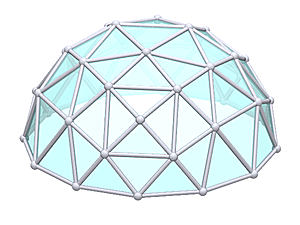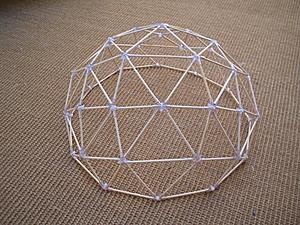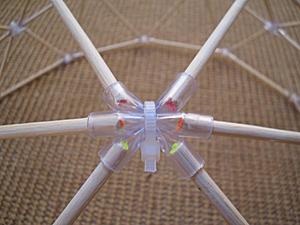|
Site Search
If you found the information useful, consider to make a donation:
| |
written by Rene K. Mueller, Copyright (c) 2005, 2006, 2007, last updated Tue, January 29, 2019
Building a model I think is very useful, you are getting an impression of the overall overhead, struts, connectors and even sewing the cover.
Yet, a model cannot replace thorough investigation of the actual method and construction; I tend to make small tests in actual size for critical parts of a construction.
Anyway, I made a couple of geodesic models, four of them I include here in more details.
Please note, the notion of the strut types (lengths) A-F for 2V, 3V and the 4V Icosahedron models do not match the ones I listed previously, the strut notion for the models are those from DesertDomes.com  which I used in previous version of these notes.
In case you also used a different notion, you can easily map them to my notion, just compare the values, they are numerically the same, just the notion of A, B, C etc are different. which I used in previous version of these notes.
In case you also used a different notion, you can easily map them to my notion, just compare the values, they are numerically the same, just the notion of A, B, C etc are different.
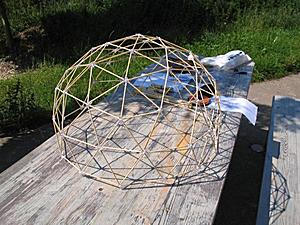
 3V 5/9 Dome, build with bamboo sticks and PVC pipe as junction |
In order to explore the form deeper, I thought to start with a model - using easy available material like bamboo sticks from a garden shop.
Other web-sites have some suggestions about building a model using PVC pipe as junction between dome struts, and this what I did then.
So, I bought
- 150 bamboo sticks (10 packages a 15 sticks), 4mm diameter, 40cm long, and
- 9m PVC pipe outer diameter 6mm, inner diameter 4mm
Cost CHF 18, € 12 or US$15. I used the 3V 5/9 calculator entered Alath+Blath+Clath = 40cm, and lhole = 0.5cm, and got my Alath, Blath and Clath to cut.
- r = 37cm, d = 74cm
- A = 11.9cm (x 60)
- B = 13.9cm (x 90)
- C = 14.2cm (x 120)
so I actually cut for a full sphere, whereas the 3V 5/9 sphere only requires A x 30, B x 55, C x 80. Following cuts I made:
Step by Step
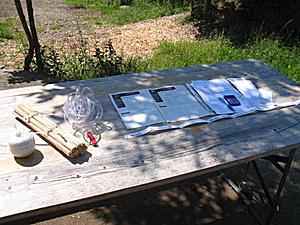 The material: bamboo sticks (40cm x 4mm, 150 pieces), PVC pipe (9m), cord
2005/08/30 12:27 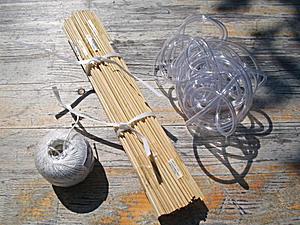 2005/08/30 12:27 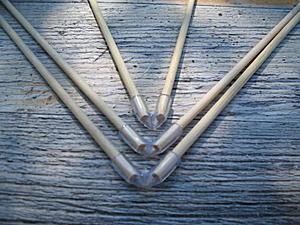 PVC junction, 1cm for each stick, 0.5cm junction = 3cm length
2005/08/30 12:27 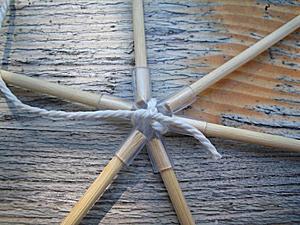 6-way junction test
2005/08/30 12:27 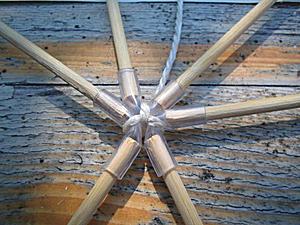 2005/08/30 12:27 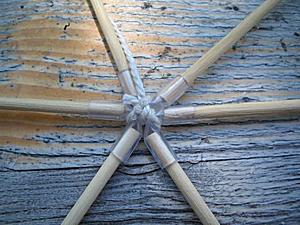 2005/08/30 12:28 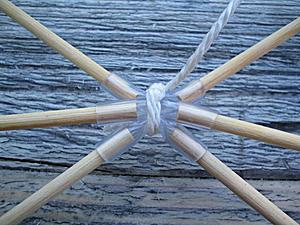 My choice to bind it
2005/08/30 12:28  Preparing the cut of A, B, and C
2005/08/30 12:28  60x A, 90x B, 120x C
2005/08/30 12:28 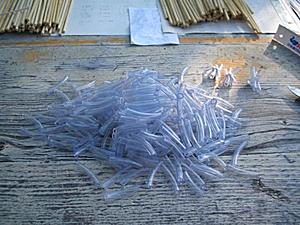 All PVC cut
2005/08/30 12:28 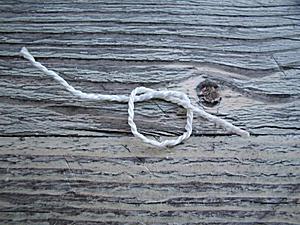 The knot, step 1
2005/08/30 12:28 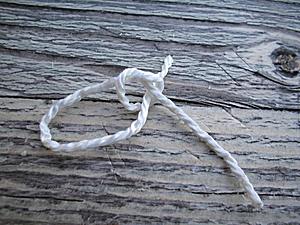 The knot, step 2
2005/08/30 12:28 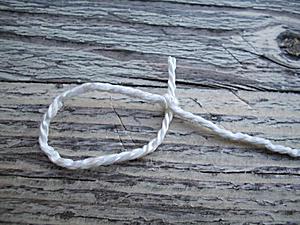 The knot, step 3
2005/08/30 12:28 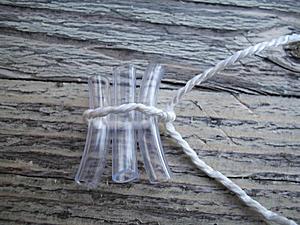 The knot, step 4
2005/08/30 12:29 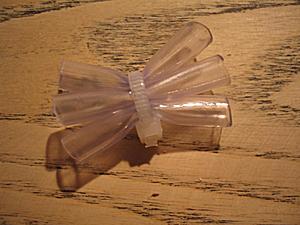 Another approach to bind the PVC pipe, easier than with a cord
2006/02/04 18:00 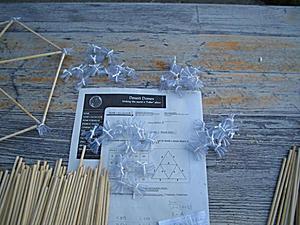 A couple of junctions (all 6-way)
2005/08/30 12:29 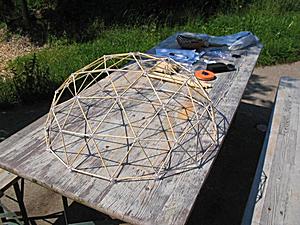 3V 3/8 Dome
2005/08/30 12:29  3V 5/8 Dome
2005/08/30 12:29  2005/08/30 12:29 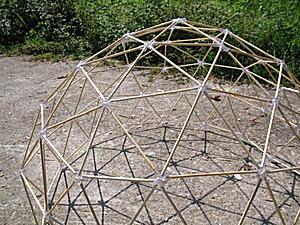 2005/08/30 12:29  2005/08/30 12:29 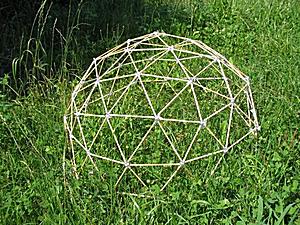 2005/08/30 12:29
As considered I used the left-over of the 3V and some spare sticks to build a 2V 4/8 Sphere:
- r = 18.3cm, d = 36.6cm
- A = 11.4cm (x 35)
- B = 10.0cm (x 30)
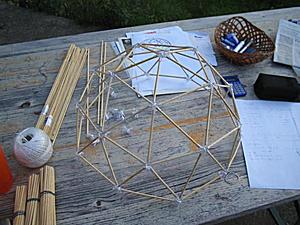 2V 4/8 Dome
2005/08/30 17:41 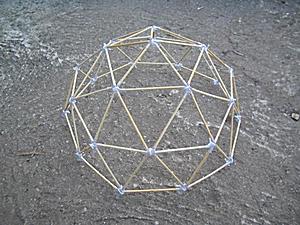 2005/08/30 17:41 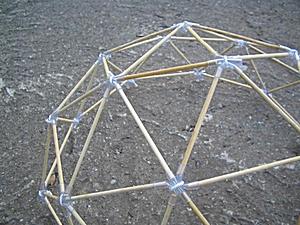 2005/08/30 17:41 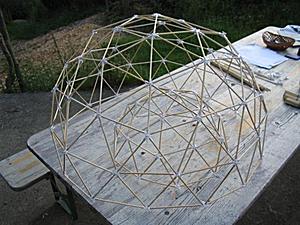 2V 4/8 Dome within a 3V 5/8 Dome
2005/08/30 17:41 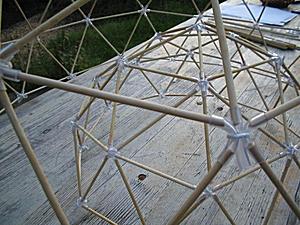 2005/08/30 17:41 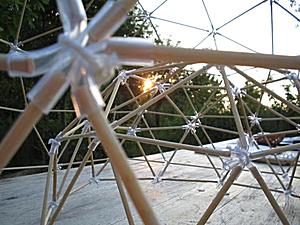 2005/08/30 17:41 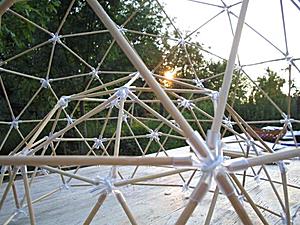 2005/08/30 17:41
It has been quite some fun to build these two models, and also sense the stability within the dome while building it.
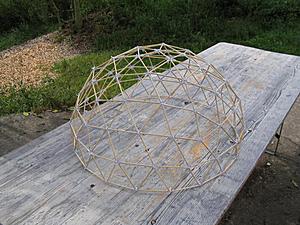
 4V 4/8 Dome |
I couldn't resist to build also the more complex 4V model, 250 struts to cut, from 63 sticks. So, D was 10cm, or 2D 20cm for the calculator:
- r = 32cm, d = 64cm
- A = 8.0cm (x 30)
- B = 9.4cm (x 30)
- C = 9.4cm (x 60)
- D = 10.0cm (x 70)
- E = 10.4cm (x 30)
- F = 9.5cm (x 30)
So, B, C and F are very close, and since cutting so small bamboo so exact is hardly possible for me I made them all the same.
The D and E I marked with color to distinct them.
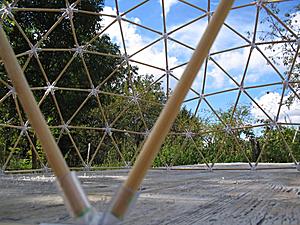
 4V 4/8 Dome (Closeup) |
Following cuts I made then:
- 60x C+D
- 5x D+D
- 30x A+E
- 30x B+F
Step by Step
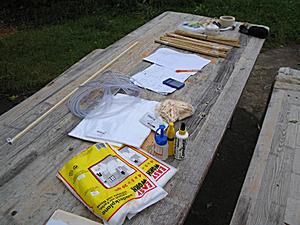 Starting the 4V Model (also parts for other models)
2005/09/10 11:31 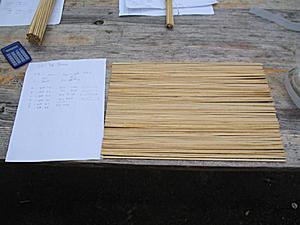 63 sticks
2005/09/10 12:13 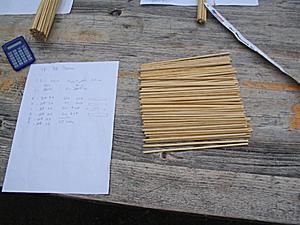 126 sticks
2005/09/10 12:31 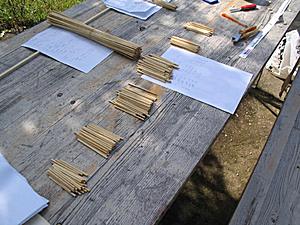 250 sticks: A, B, C, D, E and F
2005/09/10 13:25 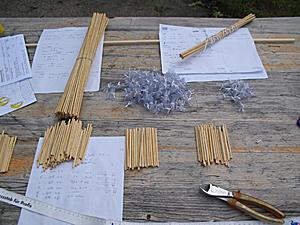 The PVC junctions, 85x 6-way and 20x 4-way
2005/09/10 15:23 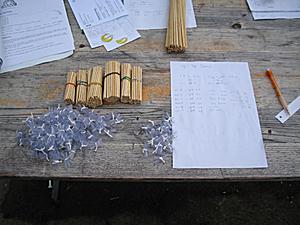 2005/09/10 15:35  4V 4/8 Dome Model
2005/09/12 12:48 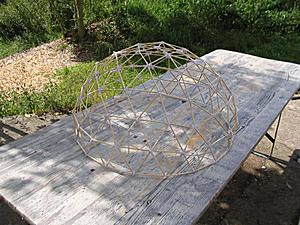 2005/09/12 12:48 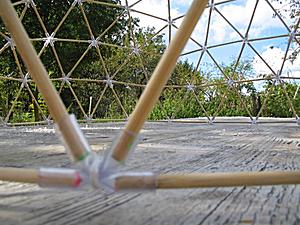 2005/09/12 12:49  2005/09/12 12:49 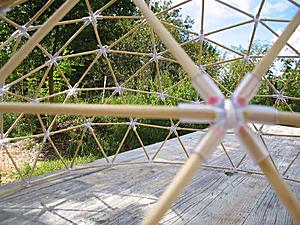 2005/09/12 12:49 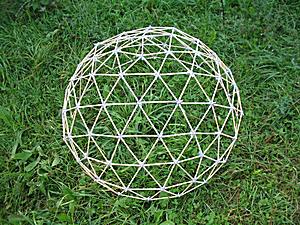 2005/09/12 12:50 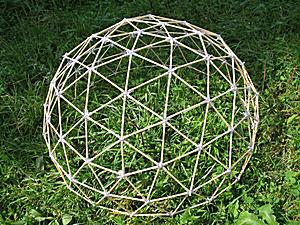 2005/09/12 12:51 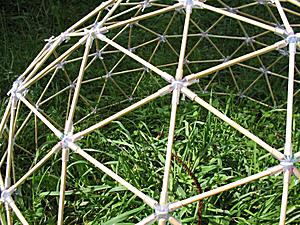 2005/09/12 12:51 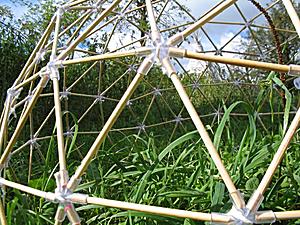 2005/09/12 12:51 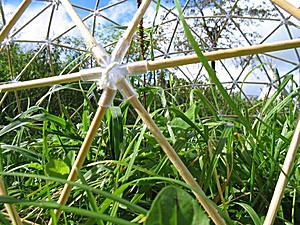 2005/09/12 12:51 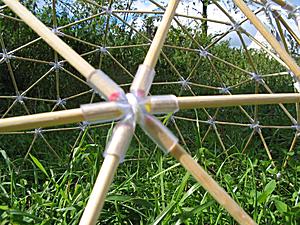 2005/09/12 12:51  2005/09/12 12:51  Size Comparison with Hand
2005/09/12 12:52
The 4V 4/8 dome came out very well, the 4mm pipe isn't narrow enough for the bamboo thereby the dome isn't as stable, e.g. when moving around. It would be better to have actually 1mm less diameter of the inner diameter of the pipe than the thickness of the sticks.
So far, the 4V looks more filigree than the 3V I think, less edgy, obvious due higher subdivision.
I made following model again with 4mm thick and 40cm long bamboo, and 6mm/4mm clear PVC pipe as connector. A quick check how to optimize the struts:
- Vertices/Connectors: 39
- Faces: 64 (3-sided)
- Edges/Struts:
- A x 24: 0.39018
- B x 24: 0.42291
- C x 30: 0.51764
- D x 12: 0.54120
- E x 12: 0.57735
- total 102 struts (5 kinds)
- strut variance 47.9%
- diameter: 2.000, radius: 1.000
- height: 0.943 or 47.15% of diameter
So I optimize:
- 12 x (A + E) = 1.0
- 12 x (A + D)
- 24 x (B + C)
- 6 x C
- total 54 laths
- (A+E) = 1.0, therefore
- A = 0.403, B = 0.436, C = 0.534, D = 0.559, E = 0.596
- (Alath+Elath) = ~20cm (using 27 x 40cm bamboo equal 54 x 20cm bamboo)
- lhole = 0.75cm, Alath = 7.5cm, Blath = 8.3cm, Clath = 10.6cm, Dlath = 11.1cm, Elath = 11.9cm
I first calculated A+E (instead of Alath+Elath) which made the struts 0.5cm longer A and B, for C, D and E the error was neglectable, but the resulting dome looked strange, until I realized those 0.75cm do really matter at that scale of the model.
So I recommend using lhole even you are doing a model at 10cm scale or so.
Next Page >>
Content: - Page 1: Table of Content, Changes
- Page 2: Introduction, Origin of the Geodesic Dome, Geodesize: Triangulate & Normalize, Procedure & Evolution of a Subdividing Triangle ...
- Page 3: Overview of Variants, Numerical Overview, Amount of Struts vs. Strut Variance, Amount of Struts vs. Strut Types ...
- Page 4: The Icosahedron, 1V/L1 2/3 Icosahedron Dome, 2V/L2 Icosahedron Dome, 3V 4/9 Icosahedron Dome ...
- Page 5: 5V 7/15 Icosahedron Dome, 5V 8/15 Icosahedron Dome, 6V Icosahedron Dome, 2V.3V Icosahedron Dome ...
- Page 6: 7V 10/21 Icosahedron Dome, 7V 11/21 Icosahedron Dome, 8V Icosahedron Dome, L4 Icosahedron Dome ...
- Page 7: The Octahedron, 1V/L1 Octahedron Dome, 2V/L2 Octahedron Dome, 3V Octahedron Dome
- Page 8: 4V Octahedron Dome, L3 Octahedron Dome, L3 1/4 Octahedron Dome, L3 5/8 Octahedron Dome
- Page 9: 5V Octahedron Dome, 6V Octahedron Dome, 2V.3V Octahedron Dome, 3V.2V Octahedron Dome
- Page 10: 7V Octahedron Dome, 8V Octahedron Dome, L4 Octahedron Dome, L4 7/16 Octahedron Dome, L4 9/16 Octahedron Dome ...
- Page 11: 9V Octahedron Dome, 3V.3V Octahedron Dome, 10V Octahedron Dome, 2V.5V Octahedron Dome, 2V.5V Octahedron Dome ...
- Page 12: The Cube, Preparing the Cube, 1V/L1 Cube Dome, 2V/L2 Cube Dome, 3V Cube Dome, 4V Cube Dome, L3 Cube Dome ...
- Page 13: 5V Cube Dome, 6V Cube Dome, 2V.3V Cube Dome, 3V.2V Cube Dome, 7V Cube Dome
- Page 14: The Cuboctahedron, Preparing the Cuboctahedron, 1V/L1 Cuboctahedron Dome, 2V/L2 Cuboctahedron Dome ...
- Page 15: 5V Cuboctahedron Dome, 6V Cuboctahedron Dome, 2V.3V Cuboctahedron Dome, 3V.2V Cuboctahedron Dome ...
- Page 16: The Truncated Octahedron, Preparing the Truncated Octahedron, 1V/L1 Truncated Octahedron Dome ...
- Page 17: The Rhombicuboctahedron, Preparing the Rhombicuboctahedron, 1V/L1 3/8 Rhombicuboctahedron Dome ...
- Page 18: Building Models, 3V 5/9 Icosahedron Model, 2V Icosahedron Model, 4V Icosahedron Model, 2V/L2 Cuboctahedron Model ...
- Page 19: Real Life Application, Options, Connectors, Separate Functions, Cover, 4/8 Sphere Cover Calculator ...
|
























































